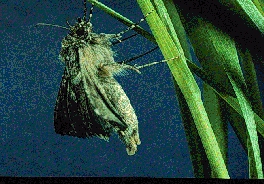Evolution of sex pheromone blends

Trichoplusia ni
, pheromone-emitting female cabbage looper moth
Chemical signals often mediate the reproductive behaviors of insects. These sex pheromones are nearly ubiquitous in moths, with females producing a blend of chemical compounds that are detected by males of the same species. Typically males will only respond to the specific blend emitted by the female. When synthetic pheromones are used in agriculture to disrupt mating, they impose selection on the communication system, leading to the potential for the evolution of resistance to this control tactic. We will study the potential for such evolutionary changes in the pheromone communication system of the cabbage looper moth. Within this species, we have discovered a single gene mutation that results in a dramatically different pheromone blend. In addition, we have determined that there are males with different response specificities to these pheromone blends. We will determine if there are inherited differences in the specificity of the males behavioral responses to different pheromone blends. Such variation would be an essential prerequisite for changes in the communication system. We will also determine if mating disruption using a typical pheromone blend results in selection favoring females with different pheromone blends, and/or males with atypical behavioral response specificities. We expect that these studies will give us new insights into the potential for evolution of resistance to synthetic pheromones when they are used to control mating behavior. By understanding this potential, we hope to preserve the utility of pheromones when they are used to control mating behavior.
This work involves a collaboration with Dr. Allen Moore (Entomology, Manchester, England).
Return to Haynes' homepage

